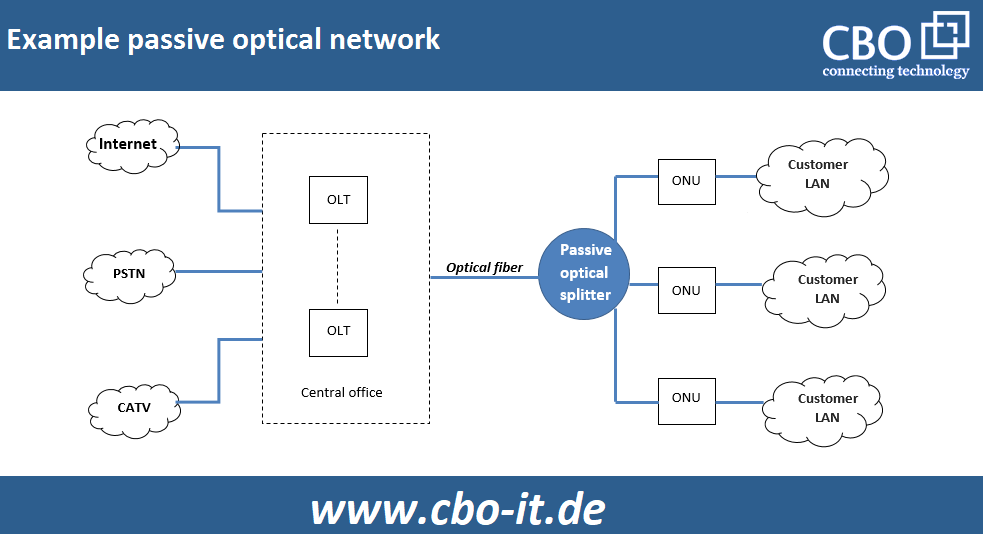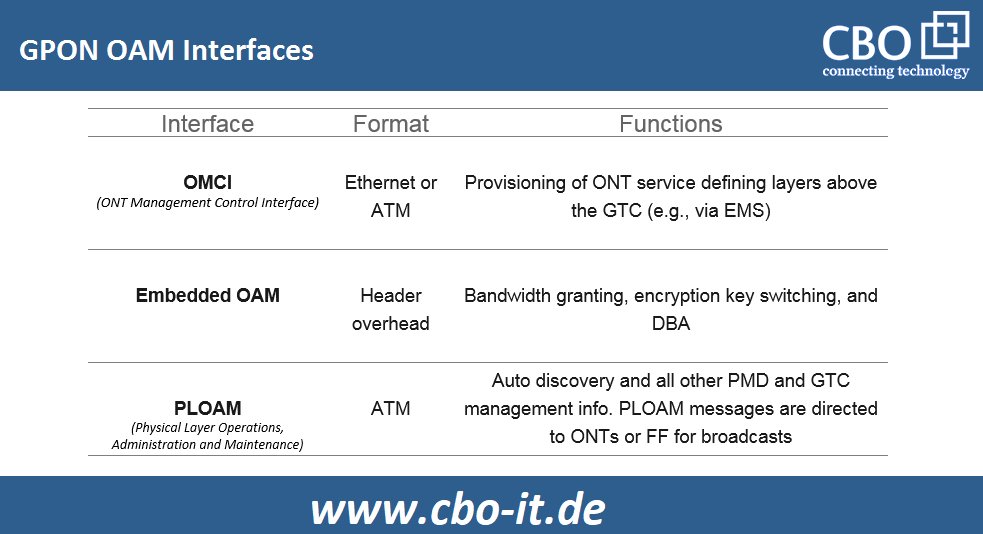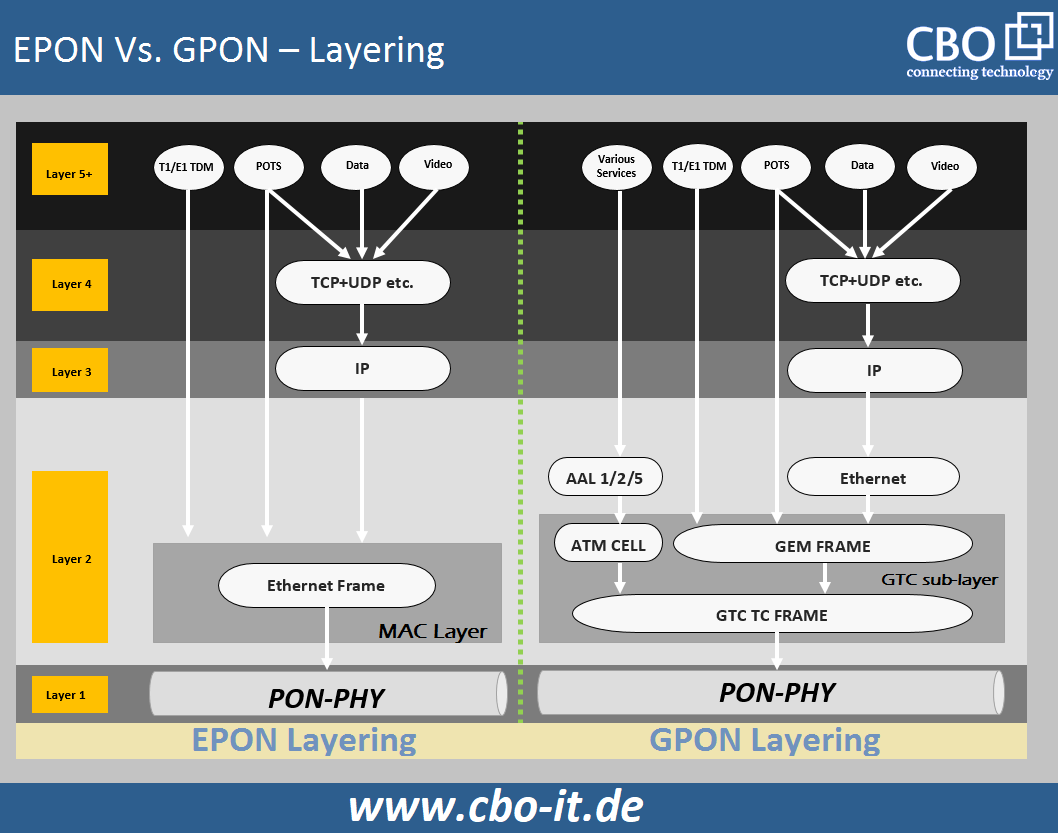Fiber is becoming the preferred medium for access level networks. It is more versatile and can offer higher capacity. PON has grown in popularity over time and service providers are aggressively investing in FTTH networks for access networks. Currently, there are several types of PON networks;
- EPON (passive optical Ethernet networks)
- GPON (passive optical gigabit network)
- BPON (broadband PON)
- APON (ATM Passive Optical Networks)
In this article, we will discuss the differences, advantages and shortcomings of GPON and EPON networks.
Basics about PON

A PON (Passive Optical Network) network comprises an OLT (Optical Line Terminal) at the service provider's headquarters and one or more ONUs (Optical Network Units) near the consumers. A single OLT can serve up to 32 ONUs in typical configurations. The word "passive" here describes the fact that the entire optical transmission within a PON network does not require any electronic parts or components. PON networks are therefore fundamentally different from active optical networks, which require electrically powered network hardware to pass frames or cells of information through the network via the optical fiber.
GPON vs. EPON - An introduction
GPON and EPON are two different types of PON and are designed to provide the world with a gigabit rate solution that can deliver IP and Ethernet services. GPON and EPON have their advantages. GPON is superior to EPON in terms of performance. However, EPON has the advantage of being cheaper and faster. We can define GPON and EPON as follows;
- GPON is based on a specially created standard. It is a viable solution for new generations of passive optical access networks in broadband applications. GPON is often used in FTTH (Fiber-to-the-Home) networks and offers the following advantages
- Transmission speeds of up to 2.5 Gbit/s
- QoS (Quality of Service), enhanced security and comprehensive protection for businesses
- Comprehensive OAM functions (operation, administration and management)
- Ethernet access for the end user
- It supports triple play
EPON is in contrast to GPON as it uses Ethernet packets instead of the ATM (Asynchronous Transfer Mode) cells that GPON uses. EPON also uses IP (Internet Protocol) to transmit video, voice and data. In FTTP (Fiber-to-the-Premises) networks, EPON is used as P2P (Point-to-Multipoint). EPON uses a single fiber optic cable to serve multiple users or premises. The key features of EPON connectivity are listed below;
- Data rates of up to 1 Gbit/s for upstream and downstream transmission
- IP-based access to data such as video, voice and internet services
Both EPON and GPON deliver Ethernet to the end user. So what's the difference between the two?
Main differences between GPON and EPON
Main differences between GPON and EPON- GPON uses a specially developed P2P protocol (point-to-multipoint)
- EPON uses Ethernet to function like GPON.
- GPON is more efficient than EPON
GPON vs. EPON - Comparison
In some aspects, GPON and EPON are equivalent, but they have different capabilities in other factors. Let's compare GPON and EPON based on some basic parameters!
GPON vs. EPON - in terms of transmission rate
GPON: GPON supports different transmission rates and can support asymmetric downlink and uplink rates. With GPON, you can choose to operate at 622Mbps or 1.25Gbps on the uplink and 1.25Gbps or 2.5Gbps on the downlink. This allows users to determine their downlink and uplink transmission speed requirements and select the appropriate optical transceiver depending on the application.
EPON: EPON can operate at a fixed uplink/downlink data rate of 1Gbps or 1.25Gbps using 8b/10b line coding.
GPON compared to EPON - in terms of splitter ratio
GPON: GPON supports both 1:64, 1:32 and 1:128. The split ratio of a particular PON network defines the number of end users it can serve. In typical scenarios, PON networks operate with a split ratio of 32, but a split ratio of 16, 64 and 128 is also possible. The performance of the optical transceivers has a major influence on the split ratio. You can choose to set up a PON network with a large split ratio, but this increases the cost of the optical transmitter and reduces the transmission range.
EPON: The standard split ratio for EPON is 1:16 to 1:32, but EPON systems with a higher split ratio such as 1:128 and 1:64 are also possible. As already mentioned, higher splitter ratios can lead to higher transceiver costs and shorter transmission distances. For example, with a splitter ratio of 1:16, EPON connections up to 20 kilometers wide are possible; with a splitter ratio of 1:32, this figure drops to 10 kilometers.
GPON vs. EPON - In Bezug auf QoS
GPON: GPON has a well-structured QoS mechanism that divides the available service bandwidth into four types. These priorities are Best Effort, Non-Assured, Assured and Fixed in order of lowest to highest priority.
In GPON networks, the DBA describes a traffic container (T-CONT) for the planning of uplink traffic. Each T-CONT (uplink traffic planning unit) is identified by an allocation ID (Alloc ID). To meet the different quality of service (QoS) requirements of different applications, each type of T-CONT is allocated an appropriate bandwidth to keep packet loss rate, delay and jitter at an optimal level.
For example;
- T-CONT type 1 is characterized by a fixed (or guaranteed) bandwidth and a fixed time slot, as it is used for delay-sensitive services such as VoIP.
- T-CONT Type 3 is characterized by a minimum guaranteed bandwidth as it is used for services where jerks are tolerable, such as web browsing.
EPON: EPON integrates a 64-byte Multipoint Control Protocol (MPCP) on the MAC layer of the Ethernet header. MPCP controls access to the point-to-multipoint network topology through timers, state machines and messages to achieve dynamic bandwidth allocation. MPCP includes the automatic detection of ONUs and their merging, the allocation of time slots for ONU transmission
GPON vs. EPON - In Bezug auf OAM
GPON: GPON defines OMCI on the upper layer, PLOAM on the physical layer and OAM on multiple layers. The following figure highlights the role of the individual management and control protocols;

EPON: EPON does not contain any special OAM protocols as it uses the provisions of IEEE 802.3ah for performance monitoring and fault isolation in conjunction with SNMP sets.
GPON vs. EPON - in terms of stratification

GPON: GPON uses two layers of encapsulation. Firstly, Ethernet and TDM frames are encapsulated in GEM frames. Secondly, GEM and ATM frames are encapsulated in GTC frames to be transported over the PON.
EPON: In this respect, EPON is simpler than GPON. In a pure Ethernet transport architecture, there is no advantage of double encapsulation as with GPON. EPON retains the simple Ethernet data format. However, it integrates a 64-byte MPCP-P2P control protocol into the Ethernet frame or header for various tasks, including bandwidth allocation and auto-detection.
GPON vs. EPON - In terms of costs
The GPON chipsets available on the market are expensive and similar to optical GPON transceivers. The cost of deploying EPON or GPON depends on the ONU/ONT, OLT and passive optical components. In typical scenarios, setting up a GPON OLT costs about twice as much as an EPON OLT. In comparison, setting up a GPON-ONT costs around 1.5 times more than an EPON-ONT. EPON is therefore cheaper than GPON.
Conclusion
Considering the above facts, we can conclude that;
- Both EPON and GPON are PON type networks
- GPON is better than EPON in terms of bandwidth and QoS
- EPON costs much less than GPON
- It is relatively easy to set up an EPON network.
In our opinion, GPON is more suitable for consumers with QoS, multi-service and high bandwidth requirements. In contrast, EPON is ideal for cost-sensitive consumer segments where security is not a major concern.
 English
English
 Deutsch
Deutsch
 Espaniol
Espaniol










